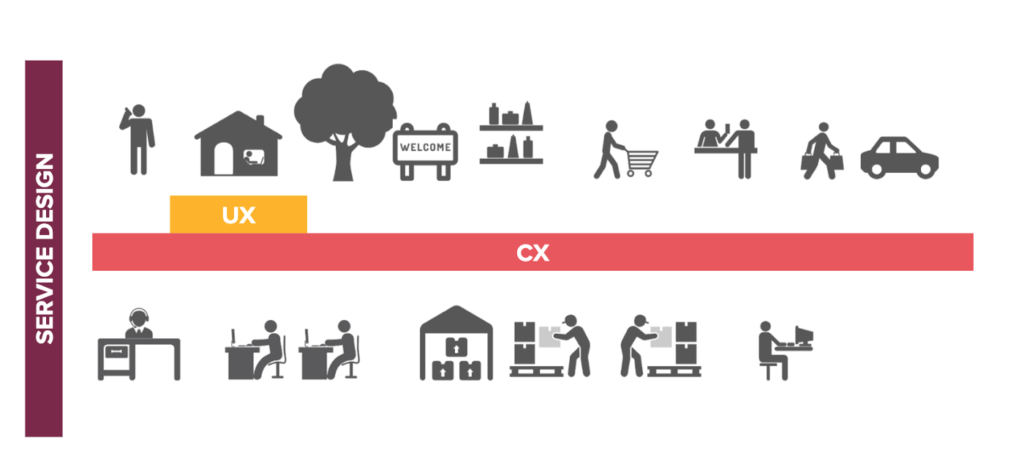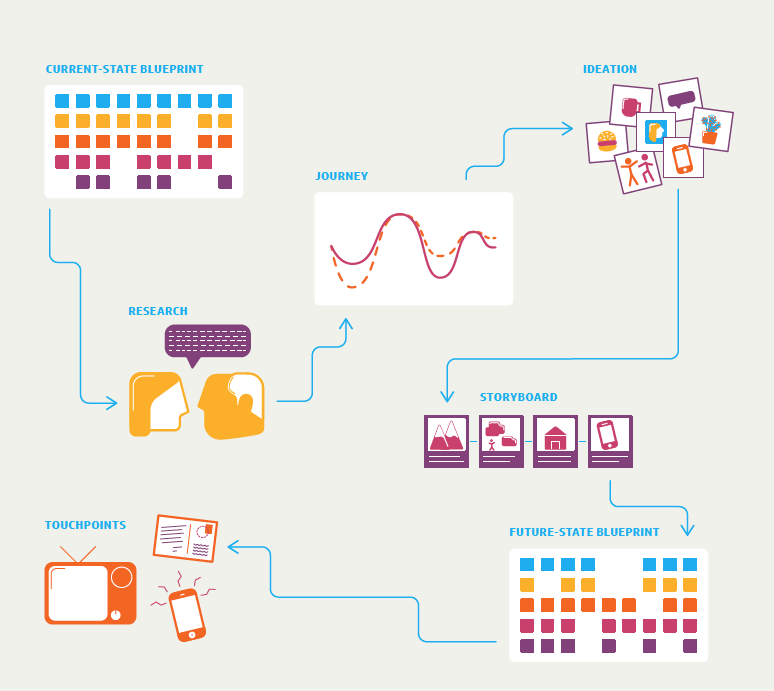In fact, according to Deloitte, in 2015 almost 70% of the Gross Domestic Product (GDP) worldwide was driven through the delivery of services, and the trend continues to grow.
 While User Experience (UX) and Customer Experience (CX) are focused on touchpoints, Service Design focuses on both the customer interactions and business operations, processes and tools.
While User Experience (UX) and Customer Experience (CX) are focused on touchpoints, Service Design focuses on both the customer interactions and business operations, processes and tools.
However, companies offering a wide ecosystem of services are often organized in silos, which undermines the communication between teams as they often do not have shared goals or aligned incentives between business units.
In addition, digital touchpoints and technological advancements have increased the complexity of interactions between people and organizations. In the banking industry, for example, customers can visit the company’s website, download the app, visit the physical bank, interact with an ATM, contact the call center, to mention a few. All of these interactions create moments of truth for the customers. Nonetheless, customers do not form their perception and opinions from individual touchpoints but from the experience with the brand as a whole, hence the importance of striving to deliver meaningful interactions in every one of these points of contact.
The need to address intertwined value exchanges between customers and organizations, and map the participation of actors such as employees, support teams, and frontline staff is becoming crucial to ensure a positive outcome.
Companies require artifacts and tools that allow them to distinguish the signal from the noise and make better, evidence-based decisions as to how to strategically orchestrate their resources. Artifacts like Service Blueprints.
What is a Service Blueprint?
Defined as a mapping method that describes all the components of a service (such as people, processes, and tools) in order to facilitate its analysis, implementation, and iteration, Service Blueprints are a core tool for Service Designers to embrace design thinking as an operating system to solve wicked problems, such as the ones encountered when designing services.
Originally proposed by Lynn Shostack in 1984, Service Blueprints help companies reduce the complexity of designing for intangible experiences that unfold over time, by translating its abstraction into a visual, tangible way to facilitate its improvement.
As an organization, investing resources in creating your Service Blueprint can drive value in three ways:
- Visualization: By showing, versus telling, blueprints expose all the moving parts associated with the service, in order for teams to address the interconnections, dependencies, and inherent complexity.
- Shared understanding: By having a single source of truth, cross-functional teams can focus the conversation around the Service Blueprint, and have thoughtful discussions to find ways of improving the service.
- Risk mitigation: Blueprints can work as low-fidelity prototypes of service delivery, in order to test its feasibility, and assess the impact and effort required before allocating resources.
 Example of Service Blueprint. Source: Mapping Experiences, Jim Kalbach.
Example of Service Blueprint. Source: Mapping Experiences, Jim Kalbach.
Anatomy of a Blueprint
Unlike Customer Journey Maps, Service Blueprints not only express the interactions of a customer with a brand, but also the operations that happen behind the scenes in order for the company to enable the customer experience. The key elements of a Service Blueprint are:
- Customer actions: The steps the customer takes while interacting with the organization’s touchpoints, such as the website, the physical store, or the app.
- Frontstage actions: All the actions a company takes that are witnessed by the customer. These frontstage actions can be divided into human-to-human, such as a customer receiving support through a call center representative, or human-to-computer, such as a customer interacting with a company chatbot.
- Backstage actions: All the actions the employees of a company take that are not visible to the customer, such as banking agents profiling customers to assess credit viability.
- Support processes: Internal processes and tools that enable companies and their employees to deliver the service. Examples range from automated emails, push notifications, or account creations.
Lines of interaction and visibility
Between the primary elements, there are lines that define the level of visibility and interaction between the actors. The most important are:
- Line of interaction: Divides the actions where the customer participates along with the company.
- Line of visibility: Separates the activities that are visible for the customer from the ones that happen behind the scenes.
- Line of internal interaction: Specifies the distinction between company employees that have direct contact or support to customers from the ones that do not.
Secondary elements
One of the biggest advantages of Service Blueprints lies in the flexibility to incorporate elements and components that can be relevant depending on the context of use. The following are some examples:
- Time: Duration of every step the customer takes, as well as the response times. This can uncover friction throughout the experience.
- Metrics: Instruments to measure the performance of the service, such as KPIs or analytics.
- Questions: When mapping as-is blueprints, addressing questions can help teams identify where to focus their research efforts in order to have more evidence around how to solve the customer experience.
Current-State vs Future-State
When it comes to classifying Service Blueprints, the most important distinction lies in the state of the customer experience, whether is addressing the challenges presented by the current state of the experience, or exploring the solution space through a to-be mindset.
Current-state Blueprints
This type of blueprints resembles a screenshot of the way the service is currently delivered. It is the radiography of the service, being particularly helpful when companies need to identify gaps in the experience, broken processes, or how organization silos impact the customer experience.
Future-state Blueprints
Future-state or to-be blueprints focus on exploring ideal ways to deliver the service. They are by definition a solution of the problem, and they become helpful when organizations are looking to have a shared understanding of the goals they want to achieve through the service delivery, as well as the optimal experience they want their customers to have.
Relationship between current-state and future-state blueprints. Source: Adaptive Path
Creating a Service Blueprint
One of the key principles of Service Design is co-creation: bringing cross-disciplinary teams to work together and break down the silos of an organization, as well as embracing the customer viewpoint in order to solve their challenges from different perspectives. Facilitating this collaboration through a structured workshop helps teams avoiding group-thinking or designing by committee while allowing every team member to have a voice and contribute to the solution of the challenge.
Nonetheless, in order to create an accurate blueprint, the company stakeholders need to be willing to invest time and resources, which makes the workshop planning a crucial activity. Following are some recommendations when organizing a Service Blueprint workshop.
Before the workshop
The first step to take before running the workshop is having the buy-in of key stakeholders, such as people who make business decisions, technical decisions, as well as people with enough visibility of the high-level operations of a company. Once you have the support of these stakeholders and have realized the value of mapping the service into a blueprint, you can start figuring out the logistics:
- Onsite vs. remote: Decide whether to run the workshop with the people in the same room or on a virtual space such as Mural.
- Gather materials: If your team decides to run the workshop on-site, prepare a large space to create the blueprint, such as a whiteboard. We recommend using post-its as they are quick to rearrange. If you decide to run it remotely, there are several resources you can leverage to facilitate the session.
- Scenarios to map: Define one or two scenarios to start mapping, depending on the customer lifecycle of the company and the touchpoints. For example, a banking company can have as scenarios awareness, customer acquisition, engagement, or recommendation. The scope of the blueprint will depend on the complexity of the scenarios. If the service is too complex, we recommend focusing on one or two touchpoints at a deep level, instead of barely mapping a wide range of channels with not enough specification.
- Gather proper research: As the facilitator of the session, you need to know the right questions to ask to focus the conversation towards the right direction. To do so, you can solicit analytics, org charts, conduct competitive analysis, and even come up with a draft of the service blueprint to facilitate the discussion.
During the workshop
So far you gained the confidence of the stakeholders, conducted some preparatory research to bring more context and knowledge to the table, and you already confirmed the participation of the team members. It is about time to start mapping the blueprint.
- Start with the customer actions: Define the entry and exit points of the customer experience upfront, and then figure out the intermediate steps. By bringing this conversation early in the workshop you can anticipate and avoid the team going beyond the initial scope of the blueprint.
- Figure out the frontstage actions step by step: Ask the participants about the interactions initiated or led by frontline customers or triggered by customer-facing systems (such as chatbots, emails, wizards). It is highly likely that participants will come up with steps that might belong to backstage or support processes. It is okay to write them down so you don’t miss them, as long as you keep the conversation around frontstage interactions.
- Move on with backstage actions: Solicit insights from participants regarding actions that employees or staff take that are not visible to the customer.
- Define support processes: Discuss with the participants all the processes that enable the actions mentioned above. For instance, If within the customer experience there is a step that includes account verification, ask for the systems that handle this verification.
Mapping one scenario takes from two to three hours. If you still have time, you can discuss with the team which other swim lanes, such as questions, metrics or time can be included, to reinforce the blueprint.
 Wizeline designers working on a website blueprint
Wizeline designers working on a website blueprint
After the workshop
Once you mapped the first version of the blueprint, it is important to refine it and add information that might have not been covered within the session. To do so, we recommend digitizing the output with online tools such as Mural or Whimsical, as their sharing capabilities will allow your team members to visualize the map, add comments, and refine it on the go. Once it’s ready for mass distribution, start socializing the artifact with other departments, and encourage its iteration so it does not become an obsolete file.
Main Takeaways
When companies successfully translate the complexity of their business and the services they offer into a visual artifact such as a Service Blueprint, they increase the likelihood of improving the customer experience by addressing areas of improvement that are clearly specified on the blueprint, as well as ways to measure their success.
If you are interested in a Service Blueprint or UX Design workshop, you can request more info here, or learn more about our design workshop offerings.

 While User Experience (UX) and Customer Experience (CX) are focused on touchpoints, Service Design focuses on both the customer interactions and business operations, processes and tools.
While User Experience (UX) and Customer Experience (CX) are focused on touchpoints, Service Design focuses on both the customer interactions and business operations, processes and tools. Example of Service Blueprint. Source: Mapping Experiences, Jim Kalbach.
Example of Service Blueprint. Source: Mapping Experiences, Jim Kalbach.
 Wizeline designers working on a website blueprint
Wizeline designers working on a website blueprint




